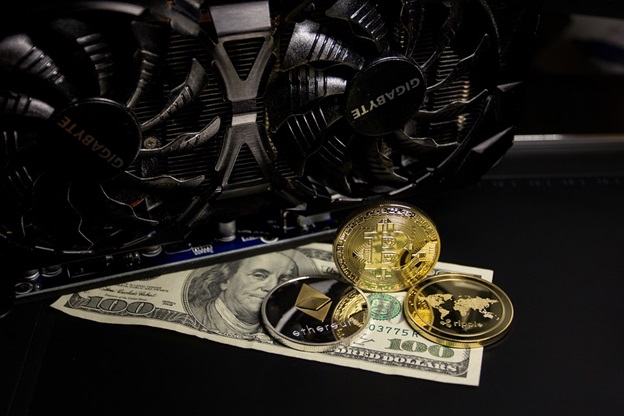
The U.S. national debt has reached a staggering $33 trillion, and it shows no signs of slowing down. This unsustainable fiscal situation poses a serious threat to the stability of the dollar and the global economy. However, some experts believe that this could also create an opportunity for Bitcoin, the decentralized cryptocurrency that is immune to inflation and government interference. We will explore how the U.S. debt crisis could affect Bitcoin’s price and why investors should consider adding it to their portfolio as a hedge against the looming financial collapse.
The U.S. debt death spiral is a term coined by Forbes contributor Clem Chambers to describe the vicious cycle of borrowing and spending that the U.S. government is trapped in. According to Chambers, the U.S. has been running massive budget deficits for decades, financed by issuing treasury bonds that are bought by foreign creditors, such as China and Japan.
However, as the debt grows larger, so does the interest payment that the U.S. has to make every year. This reduces the amount of money that the government can spend on public services and infrastructure, which in turn lowers the economic growth and tax revenue. To cover the shortfall, the government has to borrow more money, adding to the debt and interest burden.
Register for Tekedia Mini-MBA edition 19 (Feb 9 – May 2, 2026): big discounts for early bird.
Tekedia AI in Business Masterclass opens registrations.
Join Tekedia Capital Syndicate and co-invest in great global startups.
Register for Tekedia AI Lab: From Technical Design to Deployment (next edition begins Jan 24 2026).
This cycle is exacerbated by the Federal Reserve’s monetary policy, which involves printing more money and lowering interest rates to stimulate the economy. While this may provide some short-term relief, it also devalues the dollar and erodes its purchasing power over time. This makes it harder for the U.S. to repay its debt in real terms and increases the risk of inflation and hyperinflation.
Bitcoin is often regarded as a digital alternative to gold, a scarce and durable asset that can store value and serve as a hedge against inflation and currency devaluation. Unlike fiat currencies, such as the dollar, Bitcoin has a fixed supply of 21 million coins that can ever be created, making it immune to inflationary pressures.
Moreover, Bitcoin is decentralized and operates on a peer-to-peer network that is independent of any central authority or intermediary. This means that no one can manipulate, censor, or confiscate Bitcoin transactions or balances. Bitcoin users have full control over their own money and can transact with anyone in the world without intermediaries or restrictions.
As the U.S. debt crisis worsens, more investors may turn to Bitcoin as a safe haven asset that can protect their wealth from the potential collapse of the dollar and the global financial system. This could increase the demand for Bitcoin and drive its price higher in the long run.
One of the biggest threats to your financial security is hyperinflation. Hyperinflation is a situation where the prices of goods and services rise rapidly and uncontrollably, eroding the value of your money. This means that the money you have today will buy you less and less in the future, unless you invest it wisely.
Hyperinflation can be caused by various factors, such as excessive money printing, government debt, political instability, or external shocks. Some examples of countries that have experienced hyperinflation in the past are Germany in the 1920s, Zimbabwe in the 2000s, and Venezuela in the 2010s.
The author of Rich Dad Poor Dad, Robert Kiyosaki, has warned about the dangers of hyperinflation for years. He believes that the current monetary policies of central banks around the world are creating a bubble that will eventually burst, leading to a collapse of the global financial system. He advises people to protect themselves from hyperinflation by investing in real assets, such as gold, silver, real estate, or cryptocurrencies.
According to Chambers, Bitcoin could reach $1 million per coin if it captures just 10% of the global money supply that is currently held in fiat currencies. He argues that this is not an unrealistic scenario, given that Bitcoin already has a market capitalization of over $1 trillion and is growing rapidly in adoption and innovation.
Of course, investing in Bitcoin is not without risks and challenges. Bitcoin is still a volatile and speculative asset that can experience significant price fluctuations in short periods of time. Bitcoin investors should be prepared for high levels of risk and uncertainty and only invest what they can afford to lose.
Additionally, Bitcoin faces various technical, regulatory, and competitive challenges that could affect its future development and adoption. For instance, Bitcoin transactions are slow and expensive compared to other cryptocurrencies and payment systems, which could limit its scalability and usability. Bitcoin also faces legal and regulatory hurdles in many countries that could restrict its access and adoption by individuals and businesses. Furthermore, Bitcoin competes with thousands of other cryptocurrencies and blockchain projects that offer different features and advantages that could attract more users and investors.
Therefore, while Bitcoin has a lot of potential to benefit from the U.S. debt crisis, it is not a guaranteed or easy path to success. Bitcoin investors should do their own research and due diligence before making any investment decisions and be aware of the risks and opportunities involved.



